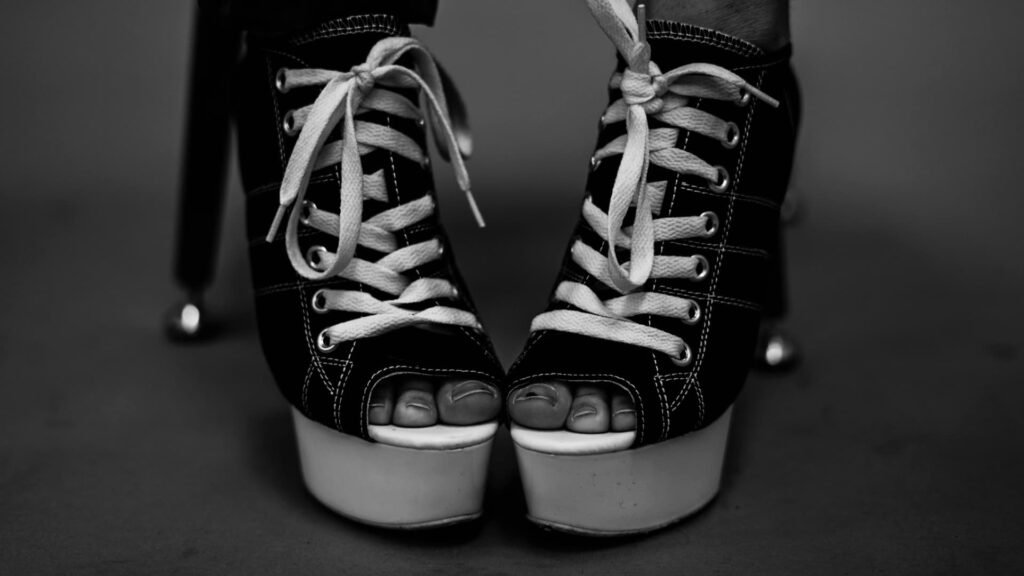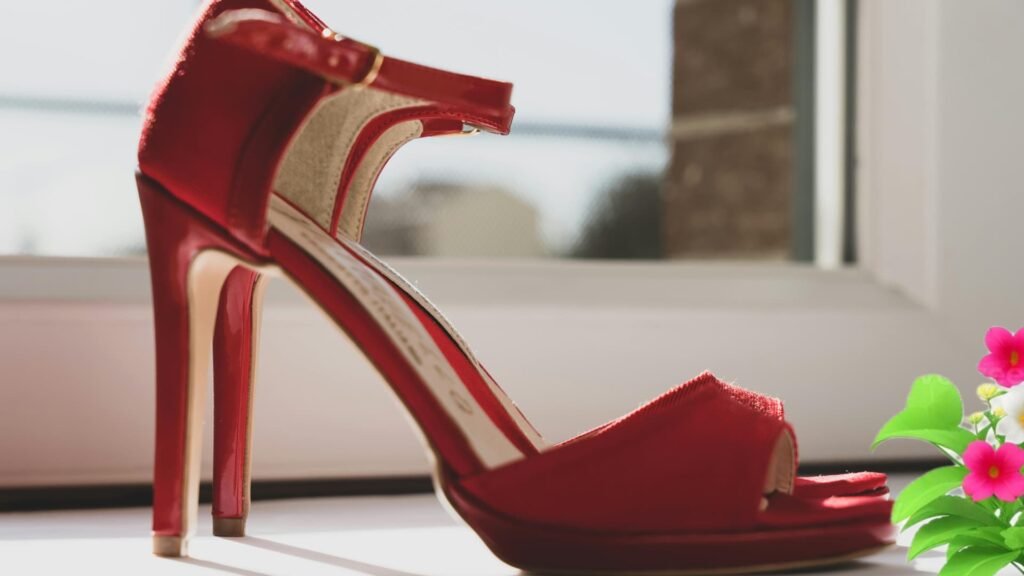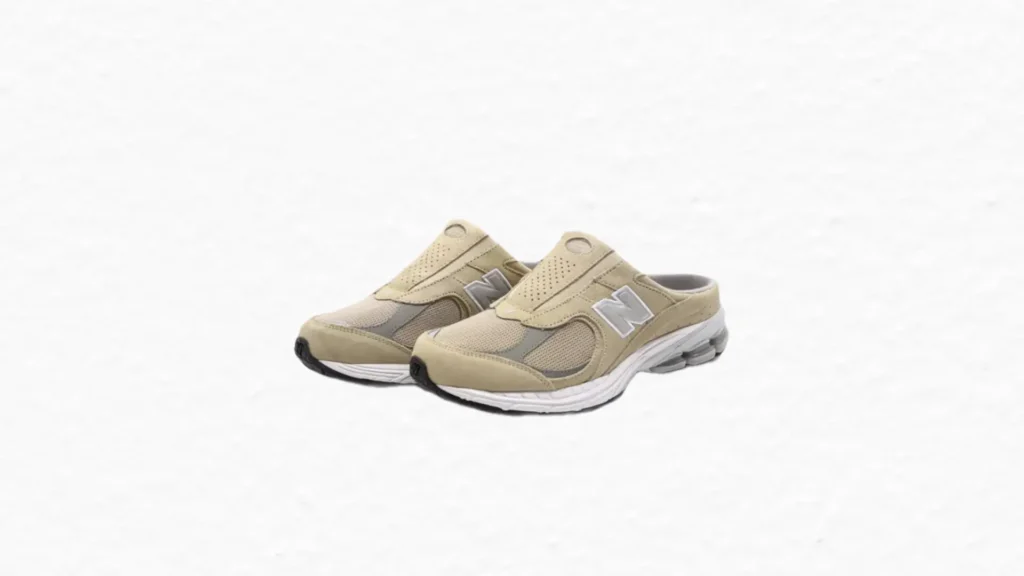High heels are a ubiquitous symbol of fashion and femininity today. They have a rich and multifaceted history. From their origins as practical footwear to their status as a symbol of power, high heels have undergone a fascinating evolution.
The Origins of High Heels
The earliest precursors to modern high heels can be traced back to ancient civilizations. They were originated for functional purposes.
In ancient Egypt (3500 BCE), elevated sandals were worn by both men and women for religious purposes. Archaeological evidence, including wall paintings and artifacts, suggests that these early heels were crafted from palm fibers and leather.
They were designed to elevate the wearer above muddy terrain. Priests and other members of the elite class wore elevated sandals during rituals to signify their elevated status above the common people.
Similarly, in ancient Greece and Rome, actors in theatrical performances wore platform sandals called kothorni or buskins. These elevated shoes were used to signify the importance of characters on stage, with taller platforms reserved for gods and heroes.
These early examples of high heels demonstrate how height-enhancing footwear was already imbued with symbolic meaning, reflecting the wearer’s elevated position in society.
How The Persians Influenced High Heels
One of the most significant developments in the history of high heels occurred during the 16th century in Persia (modern-day Iran). Persian cavalrymen wore heeled boots to secure their feet in stirrups while riding horses. This helps them to maintain stability during battles.
The heel provided a firm grip in the stirrup, and enabled riders to stand easily in the saddle. This position helped archers to shoot arrows while mounted.
When Persian diplomats visited Europe in the late 16th century, they brought their distinctive footwear with them. European aristocrats, particularly men, quickly adopted the style. They were impressed by the prowess and beauty of high heels.
The heel became associated with nobility and masculinity. It was the beginning of its transformation into a fashionable accessory. European courts, particularly in France and Italy, embraced the new trend, and soon high heels became a staple of aristocratic fashion for both men and women.
During the Renaissance and Baroque periods, high heels became an integral part of European court fashion. Both men and women of the upper classes embraced heels as a marker of wealth and privilege.
Louis XIV of France, known as Sun King, played a pivotal role in popularizing high heels among the elite. His iconic red-heeled shoes became a symbol of royal authority. Permission was needed by the king to wear them.
In this era, heels were exaggeratedly tall and ornate. They were adorned with embroidery, jewels, and intricate designs. They signified wealth and leisure. The impracticality of walking in such shoes underscored the wearer’s detachment from manual labor.
For women, corseted dresses paired with towering heels created an idealized silhouette of grace and refinement. The higher the heel, the more elevated one’s social standing appeared to be.
The 18th Century: Gendered Footwear
By the 18th century, high heels began to take on distinct gender associations. Men gradually abandoned heels. Meanwhile, women continued to wear heels.
This divergence reflected broader societal changes. Femininity came to be defined by fragility and ornamentation.
The Rococo period (1730-1770) saw the rise of the Louis heel, named after Louis XV of France. Characterized by its curved shape and moderate height, this style remains influential in contemporary shoe design.
However, the French Revolution in the late 18th century marked a temporary decline in high-heel popularity. The revolutionaries sought to dismantle the old aristocratic order, and with it, the symbols of excess, including high heels.
The Victorian Era: Restraint and Innovation
In the 19th century, high heels experienced a resurgence. The Victorian era emphasized modesty and propriety, and women’s footwear reflected these values.
Heels became lower and sturdier. They were designed to complement the restrictive corsets and voluminous skirts of the time. The emphasis was on practicality. Women were expected to navigate cobblestone streets and uneven pavements.
Technological advancements also played a crucial role in shaping the evolution of high heels. The invention of the sewing machine allowed for mass production of shoes. This helped to produce high heels for middle class.
Additionally, innovations in materials—such as vulcanized rubber—improved durability and comfort. By the end of the 19th century, heels had become varied in style, ranging from low, chunky heels to slightly higher versions.
The 20th Century: Liberation and Rebellion
The 20th century witnessed dramatic shifts in the perception and design of high heels. In the 1920s, flappers rejected traditional notions of femininity by wearing shorter hemlines and sleek, low-heeled shoes. The T-strap heel became particularly popular during this decade.
The post-war years saw the emergence of iconic styles like Christian Dior’s stiletto heel in the 1950s. Designed by Roger Vivier, the stiletto epitomized glamour and sophistication. It became synonymous with Hollywood starlets and the burgeoning consumer culture of the mid-century. Marilyn Monroe famously declared that she kept a few extra inches of heel to give her that extra bit of allure on screen.
However, the feminist movements of the 1960s and 1970s sparked debates about the role of high heels in perpetuating patriarchal beauty standards. Some women embraced heels as a form of empowerment, while others rejected them as symbols of oppression.
This tension continues to shape discussions around high heels today, as women grapple with the dual nature of heels as both liberating and constraining.
Contemporary Trends of High Heels

In the 21st century, high heels have become diverse and inclusive than ever before. Designers now cater to a wide range of tastes and body types.
Technological innovations have improved comfort. Nike and Adidas have introduced sneakers with built-in heels.
Moreover, the rise of gender-fluid fashion has challenged traditional notions of who can wear high heels. Billy Porter and Harry Styles have redefined the boundaries of masculinity by incorporating heels into their wardrobes.
At the same time, campaigns against mandatory high-heel policies in workplaces highlight ongoing efforts to address issues of choice and consent.
High heels have always been more than just footwear. They are cultural artifacts that reflect the values, norms, and aspirations of the societies in which they are worn.
Throughout history, heels have been used to signal status, power, and identity. They have been embraced by monarchs, rebels, and everyday individuals seeking to make a statement.
The evolution of high heels is a testament to humanity’s enduring fascination with elevation. From their humble beginnings as utilitarian tools to their current status as symbols of identity and self-expression, high heels have traversed continents, cultures, and centuries. As society continues to evolve, so too will the meanings and manifestations of this timeless accessory.




